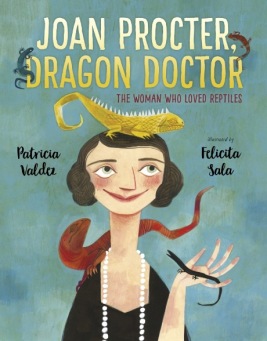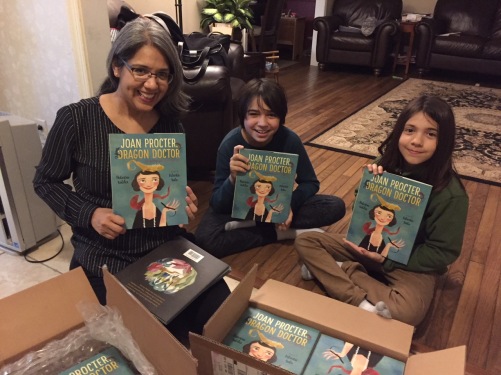Last week I shared Joan Procter, Dragon Doctor, the Woman Who Loved Reptiles, Patricia Valdez’s debut picture book about a little known female scientist. Today, Patricia shares her process of finding the heart of the story from a pile of research.
 Before becoming a published children’s book author, I was (and still am) a published scientist. In many ways, writing a picture book biography is a lot like writing a scientific paper. Before embarking on the research, you need to ask yourself what’s so important about your topic and will anyone care? Yes, the infamous “So What?” question. Joan Beauchamp Procter, the subject of my picture book biography, JOAN PROCTER, DRAGON DOCTOR: THE WOMAN WHO LOVED REPTILES, was a successful self-taught herpetologist in the early 1900’s, a time when women scientists were scarce. I knew this was an important topic since so few picture books about women scientists exist.
Before becoming a published children’s book author, I was (and still am) a published scientist. In many ways, writing a picture book biography is a lot like writing a scientific paper. Before embarking on the research, you need to ask yourself what’s so important about your topic and will anyone care? Yes, the infamous “So What?” question. Joan Beauchamp Procter, the subject of my picture book biography, JOAN PROCTER, DRAGON DOCTOR: THE WOMAN WHO LOVED REPTILES, was a successful self-taught herpetologist in the early 1900’s, a time when women scientists were scarce. I knew this was an important topic since so few picture books about women scientists exist.
 The research for both can take months to years. Once you’ve done the research, you pore over the results, try to make sense of it all and piece it together. You may need to move the pieces around until the heart of the story starts to reveal itself to you. My research involved locating Procter’s photographs, paintings, newspaper interviews, personal letters, and scientific writing. All of which revealed a no-nonsense, clever, sharp-witted, and kind woman. “Why shouldn’t a woman run a reptile house?” she replied to curious reporters. Procter was intent on showing the world their fears of the recently discovered Komodo dragons were misguided. Like the dragons, Procter was a bit misunderstood herself, since she did not follow the typical conventions of women of her time (not many 1920’s women had crocodiles at home, for instance). She developed a close connection with a Komodo dragon named Sumbawa, whom she took for walks around the London Zoo. To me, the relationship between an unconventional woman and an unconventional lizard was at the heart of the story.
The research for both can take months to years. Once you’ve done the research, you pore over the results, try to make sense of it all and piece it together. You may need to move the pieces around until the heart of the story starts to reveal itself to you. My research involved locating Procter’s photographs, paintings, newspaper interviews, personal letters, and scientific writing. All of which revealed a no-nonsense, clever, sharp-witted, and kind woman. “Why shouldn’t a woman run a reptile house?” she replied to curious reporters. Procter was intent on showing the world their fears of the recently discovered Komodo dragons were misguided. Like the dragons, Procter was a bit misunderstood herself, since she did not follow the typical conventions of women of her time (not many 1920’s women had crocodiles at home, for instance). She developed a close connection with a Komodo dragon named Sumbawa, whom she took for walks around the London Zoo. To me, the relationship between an unconventional woman and an unconventional lizard was at the heart of the story.

Just like writing a scientific paper, you will go through many drafts. During the process, you might discover holes and need to go back and do more research. Once I identified the heart of the story, I decided to weave the discovery of Komodo dragons into Procter’s story. Procter went on to dispel the myth of the “fiercer man-eating lizard.” At the same time, she dispelled the myth that women can’t be scientists. [Komodo dragon pictured above is from the National Zoo.]

Tightening the story might mean discarding some of the research you thought was so cool, but is now unnecessary. I would have loved to include the story about Procter chasing a bear out of her home, but, alas, it didn’t gel with the rest of the narrative.
And then there is the universal fear of being scooped. What if someone publishes a similar story before you? There’s not a whole lot you can do to avoid being scooped. And let me tell you, I’ve been there, both as a children’s book author and a scientist. Just tell the story on your own terms and focus on the heart you’ve identified. There may be another story out there on your subject, but chances are your “heart” is unique and worth telling.
Oh, and one last thing: don’t forget to cite your sources!

You can preorder your copy of JOAN PROCTER, DRAGON DOCTOR now. It will be available in stores March 13!
Here’s a review from School Library Journal.
Fantastic interview! Ah – the fear of being scooped is real indeed!! Your book is simply amazing and your heroine – one of a kind for her times. May she inspire many, many more future scientists through your wonderful book!
LikeLiked by 1 person
I thoroughly enjoyed learning about Patricia’s process of researching and then piecing the information together to find her hook and storyline. Fascinating. Love seeing such a strong woman role model for readers.
LikeLiked by 1 person
Very awesome! Congratulations, Patricia!
LikeLiked by 1 person
Thank you for insight into your process. I too, have published science articles and am now writing children’s books. You are right that the process is similar. Good luck with your book. I look forward to reading it.
LikeLiked by 1 person
Thanks, everyone, for your kinds comments!
LikeLiked by 1 person